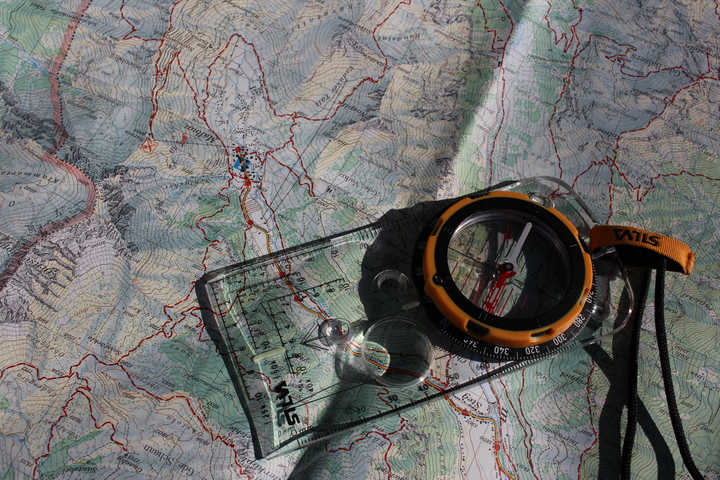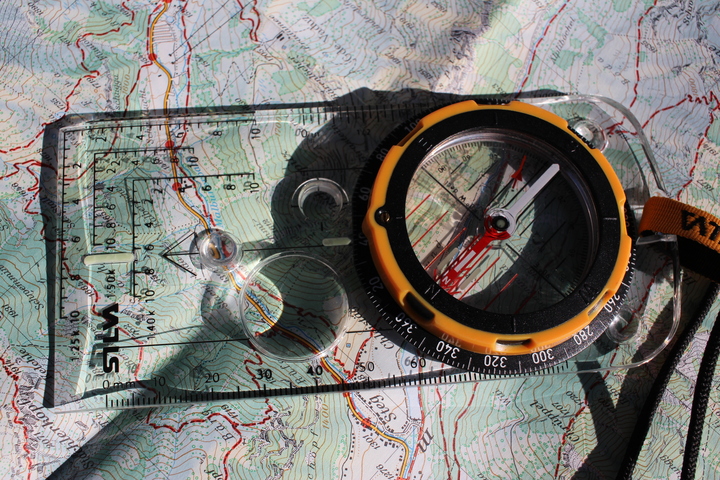Ok, before you all cry that the Expedition 4 compass has been on the de facto standard compass for every Brit venturing into the outdoors for decades why are you writing a review. Stop. This isn't a review of the Silva Expedition 4 compass. This is the newer Silva Expedition Compass. Bonus points to Silva for their highly non confusing naming scheme...

I wanted to get myself a new compass after being fed up with my old cheapy one. I asked around for recommendations and found that pretty much everyone recommends the Expedition 4. Then a Danish friend let me have a play with his Expedition, I preferred it to the Expedition 4. Which is when I discovered an issue. The Expedition 4 is only available in the UK (anyone know why?), and consequently the Expedition is not available in the UK (anyone know why?). Fortunately I found myself in Germany just before Christmas and managed to pick one up. It cost me 42 euro.
Seeing as the Expedition is almost unheard of (and very hard to buy) in the UK, I thought I'd write a brief review.
So what's the difference between the Expedition 4 and the Expedition? The first thing that stands out is the bezel. This is a bright orange and black affair that is really easy to use with gloves on and without. Compared to the Expedition 4, I prefer it.

Next up, as you study the inside of the compass you notice there is what looks like another needle in there, the inclinometer. What's one of those? Well it's for measuring the angle of incline. Why do you need that? In the UK, that's a mighty fine question. Generally as you're standing in the middle of kinder on a summers day you don't really need to know the incline of the nearest tussock. The manual suggests that the inclinometer is there to measure the angle of slopes for assessing avalanche risks. I'm not experienced in avalanche awareness, so haven't used this feature this way. But as an Arboriculture student, I've found it's really useful for measuring the height of trees. Hopefully as I venture into the mountains in winter (under the instruction of a guide at first), I will get to use this feature for what it was intended. In the mean time, do you want to know how tall this tree is?
If you look really closely at the bezel you will notice a small brass screw. If you pull the safety lanyard firmly, you'll find it splits. Inside one of the ends is a screw driver. Turn the brass screw, and you'll notice the inside of the compass turns. This is so you can adjust magnetic declination for the area you are in. When I first got home, I got out my local map to adjust it, found that my local area is 2° of declination, and didn't bother. Turns out for every map I own, the declination is next to nothing, so this feature hasn't been as useful as I had hoped... If I ever get to head up to the north of Sweden to Sarek and the like, then I can use this to adjust the 6°. Or if I get to New zealand, where the declination can be in excess of 20°.
Beyond this, the compass has the usual romer scales you would hope for - 1:40k 1:25k and 1:50k, As well as mm and inch scales. There is a magnifier for those wanting to do really close in map work, and the usual hole for marking the map. All of which you also find on the Expedition 4.
As you can see this is a compass for those wanting that little bit more. If you are out in avalanche country or plan to visit areas where magnetic declination is a bit more than your usual margin of error, then this compass is a big improvement over the Expedition 4, well worth the effort to either import it (a couple of German shops will ship them to the UK), or picking one up when abroad. If however you generally hike only in the UK, you're probably OK with the older Expedition 4. If you're not in the UK, well you can't get the expedition 4 anyway, and this is a great compass, even if you might not use all the features on offer.
For those of you who prefer to use mirror compasses, there is a mirror version of the Expedition.
J
PS Just discovered that this compass is available from The Orienteering Shop in the UK, I have no connection to them, but it's the only UK supplier that showed up on google.

I wanted to get myself a new compass after being fed up with my old cheapy one. I asked around for recommendations and found that pretty much everyone recommends the Expedition 4. Then a Danish friend let me have a play with his Expedition, I preferred it to the Expedition 4. Which is when I discovered an issue. The Expedition 4 is only available in the UK (anyone know why?), and consequently the Expedition is not available in the UK (anyone know why?). Fortunately I found myself in Germany just before Christmas and managed to pick one up. It cost me 42 euro.
Seeing as the Expedition is almost unheard of (and very hard to buy) in the UK, I thought I'd write a brief review.
So what's the difference between the Expedition 4 and the Expedition? The first thing that stands out is the bezel. This is a bright orange and black affair that is really easy to use with gloves on and without. Compared to the Expedition 4, I prefer it.

Next up, as you study the inside of the compass you notice there is what looks like another needle in there, the inclinometer. What's one of those? Well it's for measuring the angle of incline. Why do you need that? In the UK, that's a mighty fine question. Generally as you're standing in the middle of kinder on a summers day you don't really need to know the incline of the nearest tussock. The manual suggests that the inclinometer is there to measure the angle of slopes for assessing avalanche risks. I'm not experienced in avalanche awareness, so haven't used this feature this way. But as an Arboriculture student, I've found it's really useful for measuring the height of trees. Hopefully as I venture into the mountains in winter (under the instruction of a guide at first), I will get to use this feature for what it was intended. In the mean time, do you want to know how tall this tree is?
If you look really closely at the bezel you will notice a small brass screw. If you pull the safety lanyard firmly, you'll find it splits. Inside one of the ends is a screw driver. Turn the brass screw, and you'll notice the inside of the compass turns. This is so you can adjust magnetic declination for the area you are in. When I first got home, I got out my local map to adjust it, found that my local area is 2° of declination, and didn't bother. Turns out for every map I own, the declination is next to nothing, so this feature hasn't been as useful as I had hoped... If I ever get to head up to the north of Sweden to Sarek and the like, then I can use this to adjust the 6°. Or if I get to New zealand, where the declination can be in excess of 20°.
Beyond this, the compass has the usual romer scales you would hope for - 1:40k 1:25k and 1:50k, As well as mm and inch scales. There is a magnifier for those wanting to do really close in map work, and the usual hole for marking the map. All of which you also find on the Expedition 4.
As you can see this is a compass for those wanting that little bit more. If you are out in avalanche country or plan to visit areas where magnetic declination is a bit more than your usual margin of error, then this compass is a big improvement over the Expedition 4, well worth the effort to either import it (a couple of German shops will ship them to the UK), or picking one up when abroad. If however you generally hike only in the UK, you're probably OK with the older Expedition 4. If you're not in the UK, well you can't get the expedition 4 anyway, and this is a great compass, even if you might not use all the features on offer.
For those of you who prefer to use mirror compasses, there is a mirror version of the Expedition.
J
PS Just discovered that this compass is available from The Orienteering Shop in the UK, I have no connection to them, but it's the only UK supplier that showed up on google.
